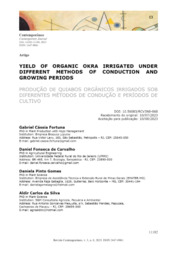Yield of organic okra irrigated under different methods of conduction and growing periods.
Yield of organic okra irrigated under different methods of conduction and growing periods.
Author(s): FORTUNA, G. C.; CARVALHO, D. F. DE; GOMES, D. P.; SILVA, A. C. da; GUERRA, J. G. M.
Summary: Okra is traditionally grown in the summer, but its cultivation in the winter can bring profitability to the producer, due to the low offer of the product, especially if grown in an organic production system. This study aimed to evaluate the yield and fruit quality of okra in organic system, in summer (SM), ratoon (RT) and winter (WN) crops. The field experiments were carried out in the SIPA (Agroecological Production Integrated System) and the total yield, marketable yield, and some quality parameters such as major and minor defects, curvature and size of fruits were evaluated in the three periods. Okra yield and fruit quality were influenced by the growing period and methods of conduction, and marketable yields of 18.3, 3.0 and 10.2 Mg ha-1 were found for SM, RT and WN, respectively. The producer should opt for a new planting during the winter instead of growing the ratoon from the summer crop.
Publication year: 2023
Types of publication: Journal article
Unit: Embrapa Agrobiology
Observation
Some of Embrapa's publications are published as ePub files. To read them, use or download one of the following free software options to your computer or mobile device. Android: Google Play Books; IOS: iBooks; Windows and Linux: Calibre.
Access other publications
Access the Agricultural Research Database (BDPA) to consult Embrapa's full library collection and records.
Visit Embrapa Bookstore to purchase books and other publications sold by Embrapa.

